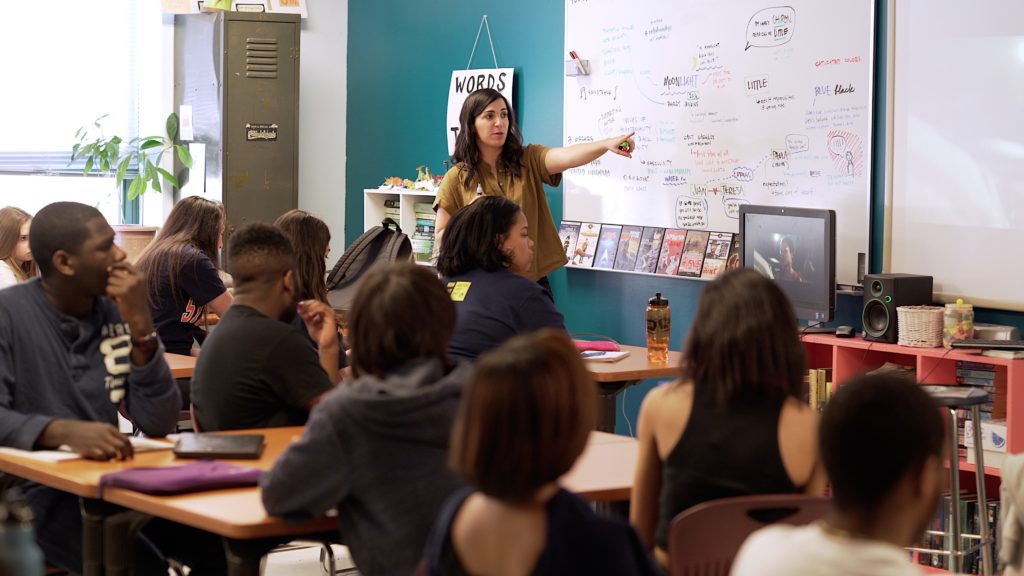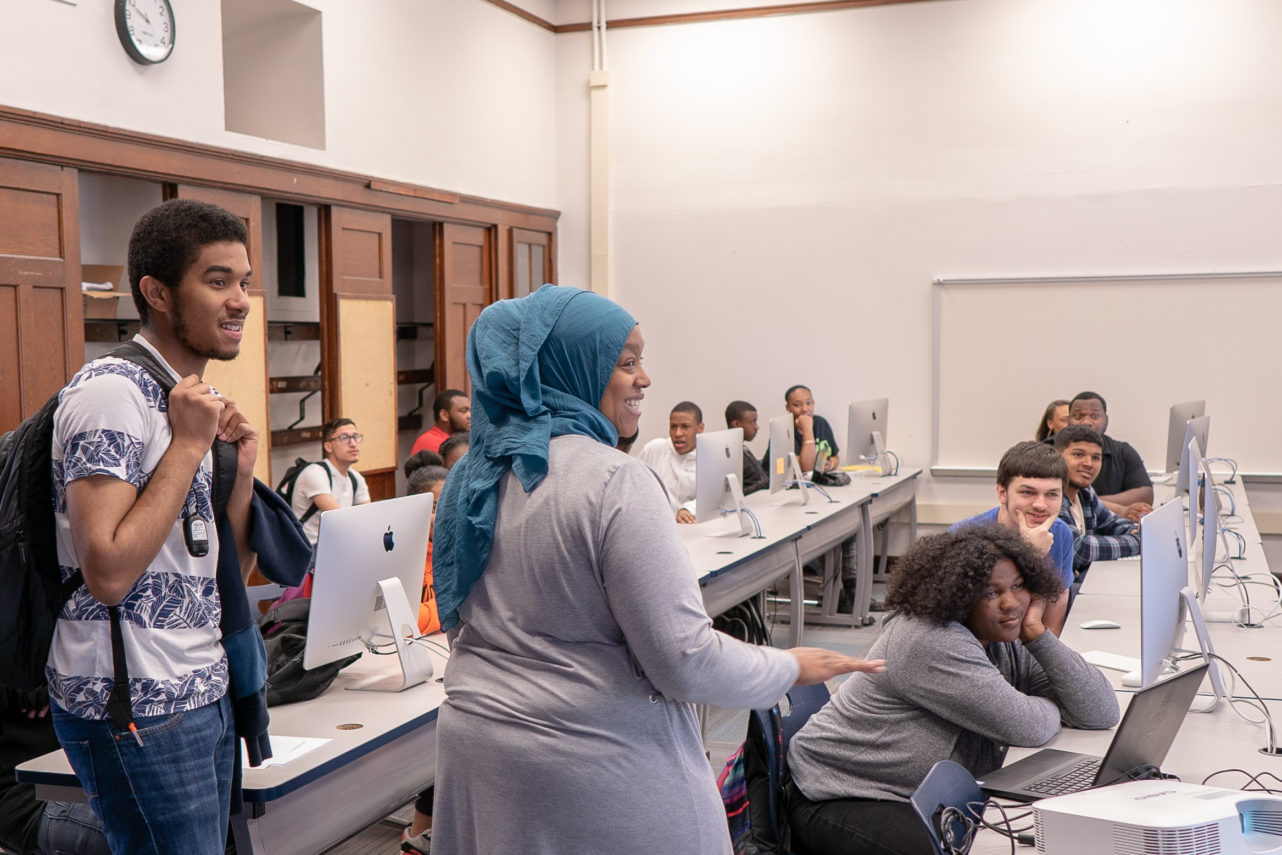The Barra Foundation’s Catalyst Fund supported four innovative high schools in Philadelphia – Building 21, Science Leadership Academy, The Workshop School, and Vaux Big Picture. During the 2017-2018 year, ImpactED, in partnership with the Foundation, engaged in an intensive year of learning about these school models. In this article–the first article in the series–we take a look back across these models and share key takeaways from the learning models at each school. To view the reports and accompanying videos for all of the schools, please visit: Sharing the Story of Impact: Philadelphia Innovation High Schools.
After spending the first few months of the school year engaged in the process of searching for internships, twenty 11th grade students at The Workshop School gathered in a classroom next to an auto-shop in the basement of a building in West Philadelphia. During Ms. Rowe’s 11th grade advisory, they reflected on their first week of internships.

One student beamed about his experience working in a theatre, “I chose this internship because I wanted to build business skills for my future career.” Another student, who had decided to explore her options and take on two internships, one with Amtrak and the other with the People’s Emergency Center, explained how the model works, “They help you find what you want to do, but really it’s up to you.” For some students, the process of landing an internship wasn’t without its challenges. This student shares that she hasn’t been able to start her internship yet because she doesn’t have a state ID or a social security card.
At other schools, this student’s experience may be viewed as a barrier that would be too challenging for a student to overcome. But the principle of persist and improve is central to the Workshop School’s model. As co-founder Matt Riggan explains, “Students spend the first half of the year getting their internship and the rest of the time being placed in their actual internship. But the first part of the year isn’t just the preamble, it’s just as important as the actual experience.” Teachers create the structure, but ultimately, the students are responsible for navigating through the process. And just like with job searching in the real-world, it’s the level of persistence through obstacles that matters most.
Challenging the traditional approach to education and continuously learning from failure is at the core of the Workshop School’s culture. This approach requires teachers to relinquish control, which can be intimidating. But strong peer support encourages teachers to take chances and do things differently. As one veteran educator, Katrina Clark, shares, “Sometimes you just need to try something. It might fail, but that’s OK because that’s how life works.”
There’s no single definition of what is meant by an “innovative” approach to education. Each of the four schools profiled in our analysis has a unique philosophy and set of guiding principles:
- Building 21 (B21) tracks students on the same academic and non-academic skills over high school through a competency-based model.
- Science Leadership Academy (SLA) uses a rigorous and modern inquiry driven project-based curriculum that exists within a culture of caring.
- The Workshop School (Workshop) has advisories that focus on project-based work. Starting in their 11th grade year, students have the opportunity to participate in four career pathways.
- Vaux Big Picture High School (Vaux Big Picture) is focused on promoting real world learning where students learn through internships.
Despite their differences, in each of the four profiled high schools, failure is not viewed as a negative, but instead, as an essential part of the learning process. As early education reformer John Dewey said, “Failure is instructive. The person who really thinks, learns quite as much from his failures as from his successes.”

Unfortunately, this approach to failure is often at odds with the current focus on high-stakes accountability in K-12 education. To respond to the pressures of demonstrating more immediate results, school leaders tend to treat challenges as technical problems, focused on quick and efficient solutions, instead of seeking adaptive solutions, which can require changing fundamental values and approaches.
Our analysis reveals that implementing innovative educational models requires leaders to think about education in an entirely new way.
Relationships are a priority
Traditionally, we think of a teacher’s role as primarily focused on the delivery of academic content. In contrast, educators across the four profiled schools take a human-centered approach to education, where getting to know students on a personal level is paramount. To facilitate these relationships, each school incorporates an advisory period that intentionally builds community and addresses the challenges students face outside of the school building.
This emphasis on relationships isn’t viewed as “separate” from the academic experience, but rather, as an integral part of the educational philosophy. In the words of SLA’s Founder Chris Lehmann, “When we started, we thought we had two very different tracks of thought – one was the inquiry driven learning model and the other was the ethic of care … and then what we realized was how deeply linked those two things are, and when you combine those two things you have something pretty powerful.”
Curriculum and assessment are evolving
The traditional school model is typically structured as a one size fits all approach. In contrast, across the four profiled schools, educators work to personalize learning to meet students’ varying interests and needs. As B21 Principal Ayris Colvin shares, “We really try to work with individual students based on where they are and create pathways for them to accelerate to help them achieve whatever it is they are interested in.” Each school takes a holistic approach to learning, one that emphasizes non-academic skills (e.g., growth mindset, agency) as much as traditional academic competencies. Instead of demonstrating learning through traditional assessments, students share their work with the community through exhibitions, where they present the product of, as well as the process behind, their learning.

The real world plays an essential role
Learning typically occurs in the four walls of a school building and remains disconnected from students’ daily lives. As David Bromley, Executive Director of Big Picture Philadelphia shares, this means that “For too many of our youth, high school is not very meaningful.” To increase the relevance of high school, all four profiled schools ensure that students’ learning is focused on the real world, through both applied projects in school and internships across the city. These experiences expose students to new parts of Philadelphia and build new skills that will be necessary for their post-secondary success.
Teachers assume a different role
It requires a particular mindset to be a successful teacher in an innovative school model that values both student voice and choice. Indeed, empowering students with ownership is easier said than done. As Amal Giknis, a Science Leadership Academy teacher shares, “I think it’s challenging for teachers to let go. You don’t know how kids will approach it when you really give them control over their own learning.” In this new power dynamic, teachers can struggle to find their “sweet spot” between developing positive relationships with students and holding them accountable to abiding by shared norms and producing high quality work.

In these innovative schools, students engage in a strikingly different type of learning experience when compared to traditional high schools. But much still remains to be learned about the impact of innovative models on student outcomes, as well as how various approaches would transfer to other schools.
To be sure, implementing this type of model requires technical change, to build an advisory structure into scheduling, to identify and develop high-quality instructional materials, and to provide necessary transportation and training to facilitate the internship process, among other changes.
More notably, it requires adaptive change. Policymakers and funders must support a holistic approach to student learning, as well as a broader definition of student success. And educators must navigate the shift in power dynamics that replaces a teacher-directed environment with a student-centered one, by building strong relationships while still maintaining high expectations.
But most importantly, implementing this type of innovative approach requires a team that’s invested in the vision and committed to the adaptive change that’s necessary to make that vision a reality. As Jim Whetzel, a science educator at B21 notes, “We’re still looking for the secret sauce … But what really makes it possible is the fact that we’re not stuck and that we’re always looking for ways to make it work.”
Inevitably, innovative school models will evolve, not just when they are being designed and initially implemented, but over time. From policymakers to funders and community members, we should all remember that successful innovation requires iteration and work to cultivate an environment where both students and educators are encouraged to take necessary risks and learn from their failures.
This article was produced in partnership with the Barra Foundation.

